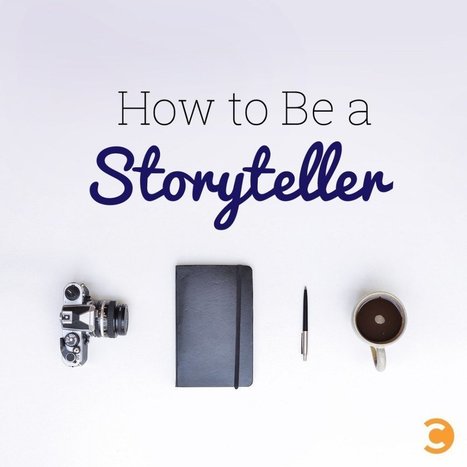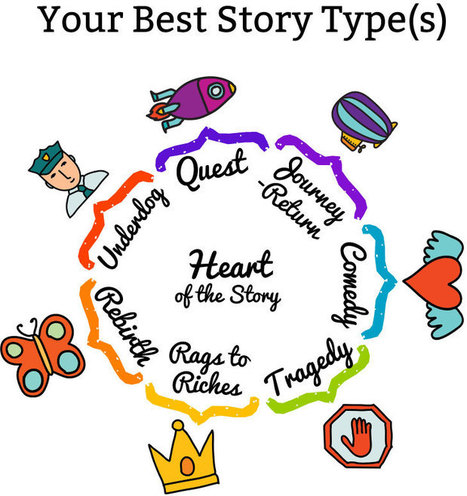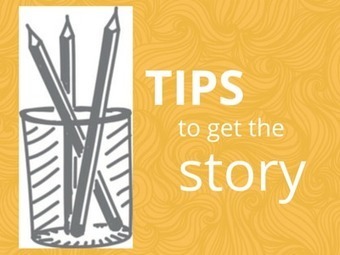 Your new post is loading...
 Your new post is loading...
"Collecting stories is one of the top challenges that non-profits site when it comes to successful storytelling. For fundraising and communications professionals, this challenge persists because they are removed from program delivery and don’t have direct access to the stories. The solution to this problem is to proactively develop a story library so that you always have a number of stories at hand for fundraising and communications materials that you might be producing." Read the full article to find out more about these 5 ways to build a story library: - Schedule a weekly time for story collecting
- Create "story time" at meetings
- Develop a story submission form
- Start an internal newsletter
- Always keep an eye out and an ear open
"As attention spans dwindle and the amount of content skyrockets, it’s important to know how to tell a good story."
Read the full article to view the Ultimate Storytelling Guide infographic which covers: - A Story About Storytelling
- What is Storytelling?
- What Will Storytelling Do for My Brand?
- Why Storytelling Works
- Finding Your Story?
- Telling Your Story?
"Between them, Dave Isay, TED Prize winner and founder of StoryCorps, and Brandon Stanton, founder of Humans of New York, have collected more than 75,000 stories from regular people around the world. Isay collects his stories as audio files, while Stanton takes a photo and then interviews his subject — but they’ve both developed fascinating techniques for helping people to open up. They sat down recently to talk about their work and their thoughts on what makes for an honest, open interview environment."
Read the full article to find out more about these tips to draw out stories from your interviewee: - A supportive culture breeds good stories.
- Engage deeply. Interrupt kindly.
- Trust in people.
- Do not commodify your stories.
- If you have a calling, pursue it relentlessly.
"I’ve been running the St. John’s Haunted Hike ghost tour and working as a professional storyteller since 1997, and along the way, I have trained many other storytellers, guides, museum workers and interpreters, volunteers, and docents about telling stories in museums, historic sites, and parks. I was recently asked for a list of things I have learning in a cultural tourism context."
Read the full article to find out more about Dale's seven storytelling tips: - People want to hear good stories, well told
- Tourists want to feel like they are in on something local, or something secret
- Tell real stories about real people
- Tell a story you love, and your audience will love it too
- Don’t be afraid of difficult stories
- Stories are a living thing
- Be mindful of whose stories you are telling, and whose stories are not being told
"While there are great ways to find those customer stories, the easiest (or laziest) seems to be launching a campaign that invites customers to share theirs, like the Arizona Families for Home Education did (at left). So routine has the “tell us your story” campaign become that there’s now a Tumblr blog dedicated to the concept. Tell Us Your Story collects campaigns shared by readers who can submit images, in addition to those ad copywriter Brian Eden finds on his own. Eden is behind the Tumblr blog, which he created after seeing “Tell us your story at drpeppertuition.com” on a Dr. Pepper can he was drinking.
Customer stories are, indeed, important, given they’re more credible than advertising or messaging from your CEO or paid spokespeople. But there are better ways—not necessarily easier, but better—for obtaining customer stories. Just watch some of the testimonial videos from The Mayo Clinic. What you see is heart-felt, authentic, and sincere, not the result of a call to action. How does The Mayo Clinic get these stories? In many cases, they’re shared with the communications team by staff with direct knowledge of the patients’ experience."
Read the full article to find out more about these other sources of customer stories that don’t require you to pimp for them: - Read the messages people send to customer service
- Use your monitoring service
- Ask your employees
- Reach out to your brand ambassadors
- Survey your customers
- Get your biggest fans in the same room
"Creating good stories is how companies convince preoccupied, information-overloaded consumers there is something worth their time and interest. Whether a company’s stories engage, educate, or entertain, they encourage a consumer to pause, even if for a short time.
But here’s the key question: How do companies get started with storytelling? The answer: a five-step process that any company can embrace."
Read the full article to find out more about these 5 steps: - Everyone Is a Storyteller
- Stay Customer-centric
- Create a “Core Story”
- Look for Stories Everywhere
- Take the Leap
Via Brian Yanish - MarketingHits.com, Pantelis Chiotellis
"In the beginning, finding good stories is difficult. If only because your brain keeps saying, “I can’t tell stories.” or “I’m not a storyteller.” Trust me; if you are breathing you tell stories."
Read the full article to find out more about these four reliable buckets that are full of good stories: - A time you shined
- A time you blew it
- A mentor
- A book/movie/folk tale
"At the end of every year, we tell ourselves a story. We piece together the narrative of our much kinder, much healthier and much more successful selves. We pack it into an unrealistic yet hopeful wish that we send out into space on December 31st.
So we make New Year’s resolutions, only to break them on January 1st. And that’s ok. We are no more than human. But a resolution that can help us on all levels is rather simple (this is not a self-help book). It’s all about finding your existing strengths and quirky, cool sides, not about reinventing yourself within a year.
It’s all about finding your own narrative and, yeah, embracing it. And this concerns both yourself and your brand. And if you want to make a few more meaningful resolutions for your business, let’s go with storytelling ones."
Read the full article to find out more about these storytelling resolutions that will help you find and tell your story this year: - Dig in your own past to find your brand’s story
- Start thinking in stories
- Do visual storytelling
- And do video storytelling. A lot of it
- Find the right channels and the right people
- Then let your customers continue the story
"According to experts, 99% of all stories ever told can be categorized into seven basic plots: Underdog, Quest, Journey/Return, Rags to Riches, Comedy, Tragedy, and Rebirth.
Understanding which plot your business/brand story falls into can help you focus your marketing messages and storytelling efforts into a more cohesive whole."
Take the quiz in this article to find out which of the seven major story plots best fits your needs.
"Many aspiring writers struggle with developing and refining their ideas. Give a classroom of students a prompt to write, and observe how many stare at their blank page or write disjointed ideas. The struggle can range from feeling as if they can't draw on any relevant experience to having so many ideas that they don't know where to start."
Read the full article to find out more about these strategies to help open your creative/reflective faucet: Prewriting - Fastwrite/Freewrite
- Journaling
Drafting - RAFTs (Role-Audience-Format-Topic-Strong Verb)
- Window Activity
Words Have Power
"In this presentation, you’ll see how stories can be used in all kinds of business settings to communicate and connect with employees, customers, colleagues, partners, suppliers, and the media.
You’ll learn the mechanics of telling a story with a beginning that hooks you, to a middle that builds tension, to a satisfying end.
You’ll learn how to weave rich information (even numbers) with personal insights and emotional power and then experience the thrill of having an audience remember what you’ve said. Many writing exercises are included to help you tap into the mind’s unique hard-wiring that can create a story out of almost any experience."
"Stories are a great tool for making yourself memorable when you meet someone new. The problem with meeting someone new is the process is so routine -- we've all done it so frequently -- that it is very easy to fall in a rut.
Almost every time you meet someone new, it is very easy to get in a habit of explaining who you are and what you do in the same way, over and over again, without thinking."
Read the full article to find out this 4-step process for creating your own personal connection story which will enable you to be much more memorable when you meet new people: - Create Story Markers
- Create a Progression of Actions, or Story Arc
- Identify the People in your Story
- Explain the Point of the Story
"I'm sure you've been at an interview or a dinner party or a fundraiser and someone asks..."tell me about yourself". Most of us define ourselves by the list of things we have done, the places we've been, the schools we've attended. But that's not who we are. We are a collection of stories, not fables, but defining moments in our journey."
Read the full article to find out more on how to find your personal story using these 5 tips: - Build the character
- Define the problem
- Outline the struggle
- What are the lessons
- Shine the light
|
Leaders are often Type-A number crunchers who hate telling stories. The result? Data-clogged speeches, dull videos, stuffy blogs and op-eds no one will publish. Here's how to mine gold. Read the full article to find out more about these 13 ways to help your executives mine their storytelling gold: - Do your research
- Establish the emotional destination
- Make it an interview
- Meet on their turf
- Ask for a grit story
- Keep an ear open for stories
- Ask directly
- Gather stories in your organization
- Share a story
- Collect stories
- Give them a heads up
- Skip the Brothers Grimm
- Follow-up
"We are hard wired for stories but I don’t think we recognize what a huge reservoir of insights, lessons learned and experiences we have to share with others.
The intent of a story. Storytellers are, by nature, collaborative and giving and can have three major choices in terms of the intent of telling their story: to inform, to inspire or to provoke.
I believe leaders in organizations need to employ the use of stories more in their communications. The question is how do you do that? How do you construct a good story you can use as a key resource in your bag of leadership tools?"
Read the full article to find out more about these 4 key steps to constructing a great business story: - Make a list of people
- Make a list of settings
- Write down problems or challenges
- Write down lessons learned
"I’m devoting this post to some of the rookie storytelling mistakes I’ve seen in my 18 years as the President of Public Words Inc. Specifically, in the form of presentations and speeches."
Read the full article to find out more about these five common rookie storytelling mistakes: - In trying for shock value, they deprive their listeners of interest.
- In a desire to be authentic, they give us too much information.
- In a desire to interest a wide audience, they fail to go deep.
- In a fear of self-disclosure, they fail to tell us the most important things.
- In a wish to appear successful, they hide their failures.
"When a librarian by the name of Carmen Nigro published a post on the New York Public Library blog entitled 20 Reasons Why You Should Write Your Family History, personal historians and APH members around the world rejoiced. Ms. Nigro had tapped into the multitude of absolutely terrific reasons individuals, families and organisations should consider working with a personal historian to preserve their stories.
Tomorrow, we launch the first in a weekly, 20-part series inspired by the New York Public Library blog post. The following 20 members of the Association of Personal Historians will expand upon each of the 20 important motivations listed in Nigro’s article."
At the time of this post, the series was at #8. Bookmark the site so you don't miss any future articles. To find out what each of the 20 topics will be about, read the blog 20 Reasons Why You Should Write Your Family History that kick-started this series. But expect to find out about the how important your stories are to future generations, depict your ancestors how you see fit, therapeutic value, and much more.
"When reorienting a brand and clarifying their core reason for being, companies are too often satisfied with a shallow exploration, settling on empty cliches when they should be seeking the real concept they’re sincere about and deeply committed to.
The Slippery Part of Finding the Untold Story. It’s because it’s so obvious to “everyone.”
But when you dig a bit deeper, you discover the “everyone” is made up of all those inside the company, those who breathe this stuff everyday. But those outside the company may never have heard your story.
In other words, since it’s SO obvious to you, you no longer notice or talk about some of those subtleties that make you different. You take them for granted. You simply forget how different your company is compared to all the other choices your audience has."
Read the full article to find out more about: - the 3-step formula for fully defining a company’s untold story and unearth the human component
- the case study of how a dance school, 29 years in business, rebranded and revitalized themselves by finding their untold stories
"You’re sitting on the runway, squashed between two strangers. “Folks, we’re number 32 in queue for takeoff.” Collective groan. May as well get cozy with your neighbors. And that’s okay, because your neighbors probably have a story to share. In fact, everyone has a story. You, as the Story Sleuth, have a job to find out what that is.
If you’re reading this blog, you already know how important fundraising stories are. But here’s what many people don’t know: Good nonprofit stories can be incredibly difficult to get. Great nonprofit stories often require fieldwork — going out into shelters, soup kitchens, hospitals, or wherever a nonprofit does good work."
Read the full article to find out more about these practical tips to keep in mind when you get there: - Look for people who actually want to share their story
- Ask open-ended questions
- Conduct a conversation more than an interview
- Keep blank paper and crayons or markers on hand
- Ask the unexpected
- Remember the donor
"The problem with pivot points – events that result in major changes in your organization’s history or your personal career – is that they often slip by unnoticed. The significance of the event isn’t recognized until later.
You typically have to dig deep into the past to identify your pivots, the lessons they taught, and the opportunities they created. The reward for digging deep, however, is that past pivot points often uncover story opportunities that can help you define your brand and create memorable story-based content marketing.
To help you learn from the turning points in your or your organization’s background, I created a simple worksheet to help you locate the relevant turning points as well as uncover the details surrounding each story."
Read the full article to download the turning point worksheet and find out more about:: - two types of pivots
- the three steps to harvest pivot stories and lessons
- suggestions for filling in the worksheet
By ascribing a story to your company, you provide an illustrated example of how, why and what you do, while assigning an emotional weight to your company’s journey. The result is the creation of a brand. How can you harness that emotional response to better communicate your company’s mission and overall goals? Let’s examine some of the tenets of storytelling for business and how they can be applied to your organization."
Read the full article to find out more about these elements of a brand story and where companies can typically find them: - Inciting incident
- Rising action
- Turning point (climax)
- Falling action
- Denouement
"Telling a great story is even harder when you are living in the middle of it. This is why so many powerful and moving stories are never told.
So how do you get started on a story? How do you keep from getting overwhelmed by the details?"
Read the full article to find out more about these 10 prompts to help you find your story: - What’s unique about you?
- What is interesting about how you got to where you are at right now?
- What problem are you equipped to solve?
- What inspires you?
- What “aha!” moments have you experienced?
- How have you evolved and grown?
- How do you feel about your work, the people you interact with, and yourself?
- What is a nontraditional way to tell your story?
- What do you consider normal and boring, that others might think is cool?
- How will you change the world?
"At its core, scrapbooking is a form of storytelling. Underneath the pretty paper and stickers, scrapbookers use their photos combined with words to document their lives in a meaningful way. For many crafters, however, the words are sometimes hard to get down on the page. Many of us (yes, I’m including myself in this category!) dread the thought of penning long paragraphs of prose. So how can reluctant journalers still create pages that tell stories in meaningful ways?"
Read the full article to find out more about these seven ideas that can help you get the words flowing: - Use prompts
- Try a quote
- Make a list
- Create a timeline
- Use humor
- Record a conversation
- Hand over the journalling pen
"Have you crafted your story so well that others are likely to share it over cocktails at a dinner party? If you're like most entrepreneurs, you probably haven't. Most founders take the time to think about their company's mission and purpose, and that's hard enough. But having a mission and a purpose is not the same thing as expert storytelling.
Write a story you could tell to anyone, anywhere. Make it so simple that anyone from a child in kindergarten to the Chairman of the Board can understand."
Read the full article to find out more about these tips on how to break storytelling down into a 5-step process: - Who are you talking about?
- Define the problem or opportunity in simple terms
- What is it that [your company] can do to help solve that problem?
- What does solving this problem do? Or what does our client think solving this problem will do for them?
- What's the customer's customer story?
"Randy Olson uncovered the And, But, and Therefore method from the most unlikely place. South Park. He was watching a documentary, “6 Days to Air,” about the manic schedule Trey Parker follows to create each episode of the crass but brilliant cartoon, when the secret was unveiled. When a script isn’t working for Parker, he goes back and replaces “ands” with “buts,” which creates conflict and tension in the story: the secret sauce to entertaining an audience. The tension then requires resolution, or the “therefore”: the conclusion of every story. It’s a simple and perfect three-act storytelling structure. Foolproof. Even for Cartman."
Read the full article to find out more and see a video about the And, But and Therefore method.
|



 Your new post is loading...
Your new post is loading...



































This is truly about being aware and making stories a priority.